Development of an Improved Peroxidase-Based High-Throughput Screening for the Optimization of D-Glycerate Dehydratase Activity
Abstract
1. Introduction
2. Results
2.1. Development of a Peroxidase-Based High Throughput Screening Method
2.2. Effect of Media Components on the Peroxidase-Based D-Glycerate Dehydratase Assay
2.3. High-Throughput Screening for Improved D-Glycerate Dehydratase Activity
2.4. Analysis of Enzymatic Properties of the Selected D-Glycerate Dehydratase Variant
3. Discussion
4. Materials and Methods
4.1. Chemicals and Enzymes
4.2. Cloning of the SsDHAD Gene and Generation of an SsDHAD Mutant Library
4.3. Screening Method for Improved SsDHAD Variants
4.4. D-Glycerate Dehydratase Activity Assay
4.5. Expression and Purification of SsDHAD Variants
4.6. Determination of Protein Concentrations and Purity
4.7. HPLC Analytics
4.8. Enzymatic Activity for Dehydration of D-Glycerate or D-Gluconate
4.9. Thermal Stability
Supplementary Materials
Author Contributions
Funding
Conflicts of Interest
Abbreviations
| ABTS | 2,2-Azino-bis-3-ethylbenzothiazolin-6-sulfonic acid |
| DHAD | Dihydroxyacid dehydratase |
| E. coli | Escherichia coli |
| ep-PCR | Error-prone PCR |
| LDH | Lactate dehydrogenase |
| NAD+, NADH | Nicotinamide adenine dinucleotide |
| SOD | Superoxide dismutase |
| SsDHAD | Dihydroxyacid dehydratase from Sulfolobus solfataricus |
| TTP | Thiamine pyrophosphate |
| U | Enzyme unit |
References
- Anastas, P.T.; Warner, J.C. Green Chemistry: Theory and Practice; Oxford University Press: Oxford, UK, 1998; p. 135. [Google Scholar]
- Singh, R.; Kumar, M.; Mittal, A.; Mehta, P.K. Microbial enzymes: Industrial progress in 21st century. 3 Biotech 2016, 6, 174. [Google Scholar] [CrossRef]
- Ye, L.; Yang, C.; Yu, H. From molecular engineering to process engineering: Development of high-throughput screening methods in enzyme directed evolution. Appl. Microbiol. Biotechnol. 2018, 102, 559–567. [Google Scholar] [CrossRef] [PubMed]
- Arnold, F.H. Directed Evolution: Bringing New Chemistry to Life. Angew. Chem. Int. Ed. 2018, 57, 4143–4148. [Google Scholar] [CrossRef] [PubMed]
- Lutz, S. Beyond directed evolution-semi-rational protein engineering and design. Curr. Opin. Biotechnol. 2010, 21, 734–743. [Google Scholar] [CrossRef] [PubMed]
- Singh, R.K.; Tiwari, M.K.; Singh, R.; Lee, J.K. From protein engineering to immobilization: Promising strategies for the upgrade of industrial enzymes. Int. J. Mol. Sci. 2013, 14, 1232–1277. [Google Scholar] [CrossRef] [PubMed]
- Hao, J.; Berry, A. A thermostable variant of fructose bisphosphate aldolase constructed by directed evolution also shows increased stability in organic solvents. Protein Eng. Des. Sel. 2004, 17, 689–697. [Google Scholar] [CrossRef] [PubMed]
- May, O.; Nguyen, P.T.; Arnold, F.H. Inverting enantioselectivity by directed evolution of hydantoinase for improved production of L-methionine. Nat. Biotechnol. 2000, 18, 317–320. [Google Scholar] [CrossRef]
- Spadiut, O.; Nguyen, T.T.; Haltrich, D. Thermostable variants of pyranose 2-oxidase showing altered substrate selectivity for glucose and galactose. J. Agric. Food Chem. 2010, 58, 3465–3471. [Google Scholar] [CrossRef]
- Sriprapundh, D.; Vieille, C.; Zeikus, J.G. Directed evolution of Thermotoga neapolitana xylose isomerase: High activity on glucose at low temperature and low pH. Protein Eng. 2003, 16, 683–690. [Google Scholar] [CrossRef]
- Bornscheuer, U.T.; Huisman, G.W.; Kazlauskas, R.J.; Lutz, S.; Moore, J.C.; Robins, K. Engineering the third wave of biocatalysis. Nature 2012, 485, 185–194. [Google Scholar] [CrossRef]
- Xiao, H.; Bao, Z.; Zhao, H. High Throughput Screening and Selection Methods for Directed Enzyme Evolution. Ind. Eng. Chem. Res. 2015, 54, 4011–4020. [Google Scholar] [CrossRef] [PubMed]
- Devine, P.N.; Howard, R.M.; Kumar, R.; Thompson, M.P.; Truppo, M.D.; Turner, N.J. Extending the application of biocatalysis to meet the challenges of drug development. Nat. Rev. Chem. 2018, 2, 409–421. [Google Scholar] [CrossRef]
- Sperl, J.M.; Sieber, V. Multienzyme Cascade Reactions-Status and Recent Advances. ACS Catal. 2018, 8, 2385–2396. [Google Scholar] [CrossRef]
- Guterl, J.K.; Garbe, D.; Carsten, J.; Steffler, F.; Sommer, B.; Reisse, S.; Philipp, A.; Haack, M.; Ruhmann, B.; Koltermann, A.; et al. Cell-Free Metabolic Engineering: Production of Chemicals by Minimized Reaction Cascades. Chemsuschem 2012, 5, 2165–2172. [Google Scholar] [CrossRef] [PubMed]
- Gmelch, T.J.; Sperl, J.M.; Sieber, V. Optimization of a reduced enzymatic reaction cascade for the production of L-alanine. Sci. Rep. 2019, 9, 1–9. [Google Scholar] [CrossRef] [PubMed]
- Xie, L.; Wei, X.; Zhou, X.; Meng, D.; Zhou, R.; Zhang, Y.P.J.; Xu, S.; You, C. Conversion of d-glucose to l-lactate via pyruvate by an optimized cell-free enzymatic biosystem containing minimized reactions. Synth. Syst. Biotechnol. 2018, 3, 204–210. [Google Scholar] [CrossRef]
- Li, Z.; Yan, J.; Sun, J.; Xu, P.; Ma, C.; Gao, C. Production of value-added chemicals from glycerol using in vitro enzymatic cascades. Commun. Chem. 2018, 1, 71. [Google Scholar] [CrossRef]
- Carsten, J.M.; Schmidt, A.; Sieber, V. Characterization of recombinantly expressed dihydroxy-acid dehydratase from Sulfobus solfataricus-A key enzyme for the conversion of carbohydrates into chemicals. J. Biotechnol. 2015, 211, 31–41. [Google Scholar] [CrossRef]
- Sperl, J.M.; Carsten, J.M.; Guterl, J.K.; Lommes, P.; Sieber, V. Reaction Design for the Compartmented Combination of Heterogeneous and Enzyme Catalysis. ACS Catal. 2016, 6, 6329–6334. [Google Scholar] [CrossRef]
- Rahman, M.M.; Andberg, M.; Thangaraj, S.K.; Parkkinen, T.; Penttila, M.; Janis, J.; Koivula, A.; Rouvinen, J.; Hakulinen, N. The Crystal Structure of a Bacterial l-Arabinonate Dehydratase Contains a [2Fe-2S] Cluster. ACS Chem. Biol. 2017, 12, 1919–1927. [Google Scholar] [CrossRef]
- Rahman, M.M.; Andberg, M.; Koivula, A.; Rouvinen, J.; Hakulinen, N. The crystal structure of D-xylonate dehydratase reveals functional features of enzymes from the Ilv/ED dehydratase family. Sci. Rep. 2018, 8, 865. [Google Scholar] [CrossRef] [PubMed]
- Bashiri, G.; Grove, T.L.; Hegde, S.S.; Lagautriere, T.; Gerfen, G.J.; Almo, S.C.; Squire, C.J.; Blanchard, J.S.; Baker, E.N. The active site of the Mycobacterium tuberculosis branched-chain amino acid biosynthesis enzyme dihydroxyacid dehydratase contains a 2Fe-2S cluster. J. Biol. Chem. 2019, 294, 13158–13170. [Google Scholar] [CrossRef] [PubMed]
- Kim, S.; Lee, S.B. Catalytic promiscuity in dihydroxy-acid dehydratase from the thermoacidophilic archaeon Sulfolobus solfataricus. J. Biochem. 2006, 139, 591–596. [Google Scholar] [CrossRef] [PubMed]
- Yan, Y.; Liu, Q.; Zang, X.; Yuan, S.; Bat-Erdene, U.; Nguyen, C.; Gan, J.; Zhou, J.; Jacobsen, S.E.; Tang, Y. Resistance-gene-directed discovery of a natural-product herbicide with a new mode of action. Nature 2018, 559, 415–418. [Google Scholar] [CrossRef]
- Childs, R.E.; Bardsley, W.G. The steady-state kinetics of peroxidase with 2,2′-azino-di-(3-ethyl-benzthiazoline-6-sulphonic acid) as chromogen. Biochem. J. 1975, 145, 93–103. [Google Scholar] [CrossRef]
- Ortiz-Tena, J.G.; Ruhmann, B.; Sieber, V. Colorimetric Determination of Sulfate via an Enzyme Cascade for High-Throughput Detection of Sulfatase Activity. Anal. Chem. 2018, 90, 2526–2533. [Google Scholar] [CrossRef]
- Zhu, A.P.; Romero, R.; Petty, H.R. A sensitive fluorimetric assay for pyruvate. Anal. Biochem. 2010, 396, 146–151. [Google Scholar] [CrossRef]
- Nishikimi, M.; Appaji, N.; Yagi, K. The occurrence of superoxide anion in the reaction of reduced phenazine methosulfate and molecular oxygen. Biochem. Biophys. Res. Commun. 1972, 46, 849–854. [Google Scholar] [CrossRef]
- Zhang, J.H.; Chung, T.D.; Oldenburg, K.R. A Simple Statistical Parameter for Use in Evaluation and Validation of High Throughput Screening Assays. J. Biomol. Screen. 1999, 4, 67–73. [Google Scholar] [CrossRef]
- Boivin, S.; Kozak, S.; Meijers, R. Optimization of protein purification and characterization using Thermofluor screens. Protein Expr. Purif. 2013, 91, 192–206. [Google Scholar] [CrossRef]
- Jaeger, K.E.; Eggert, T.; Eipper, A.; Reetz, M.T. Directed evolution and the creation of enantioselective biocatalysts. Appl. Microbiol. Biotechnol. 2001, 55, 519–530. [Google Scholar] [CrossRef] [PubMed]
- Studier, F.W. Protein production by auto-induction in high density shaking cultures. Protein Expr. Purif. 2005, 41, 207–234. [Google Scholar] [CrossRef] [PubMed]
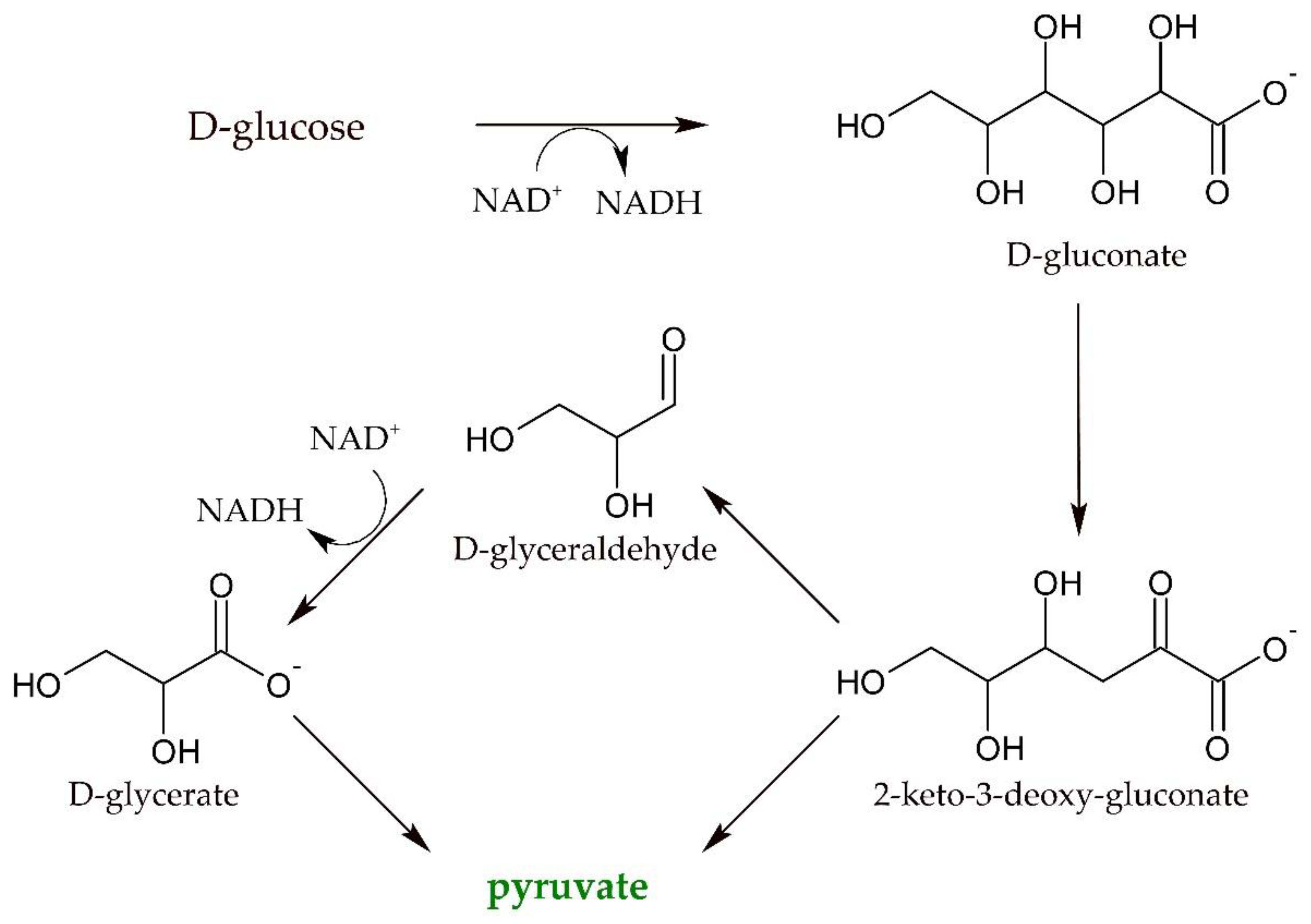
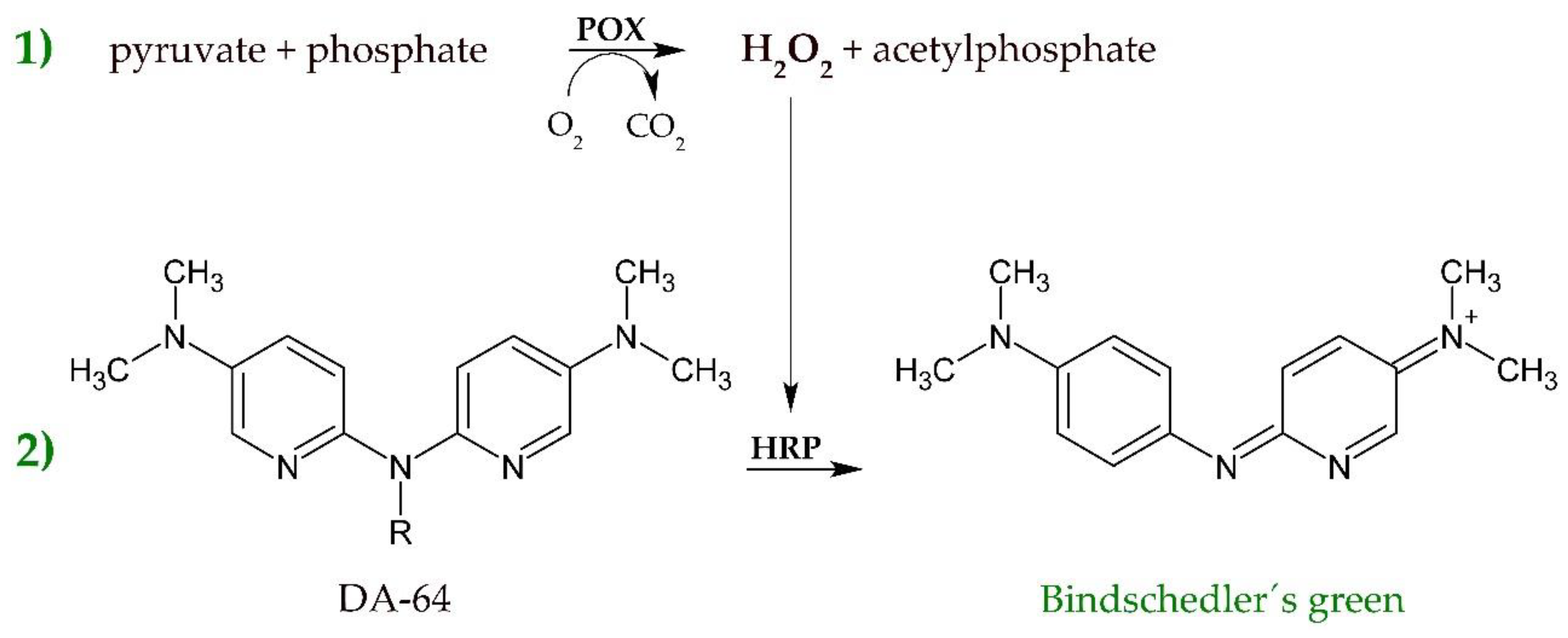
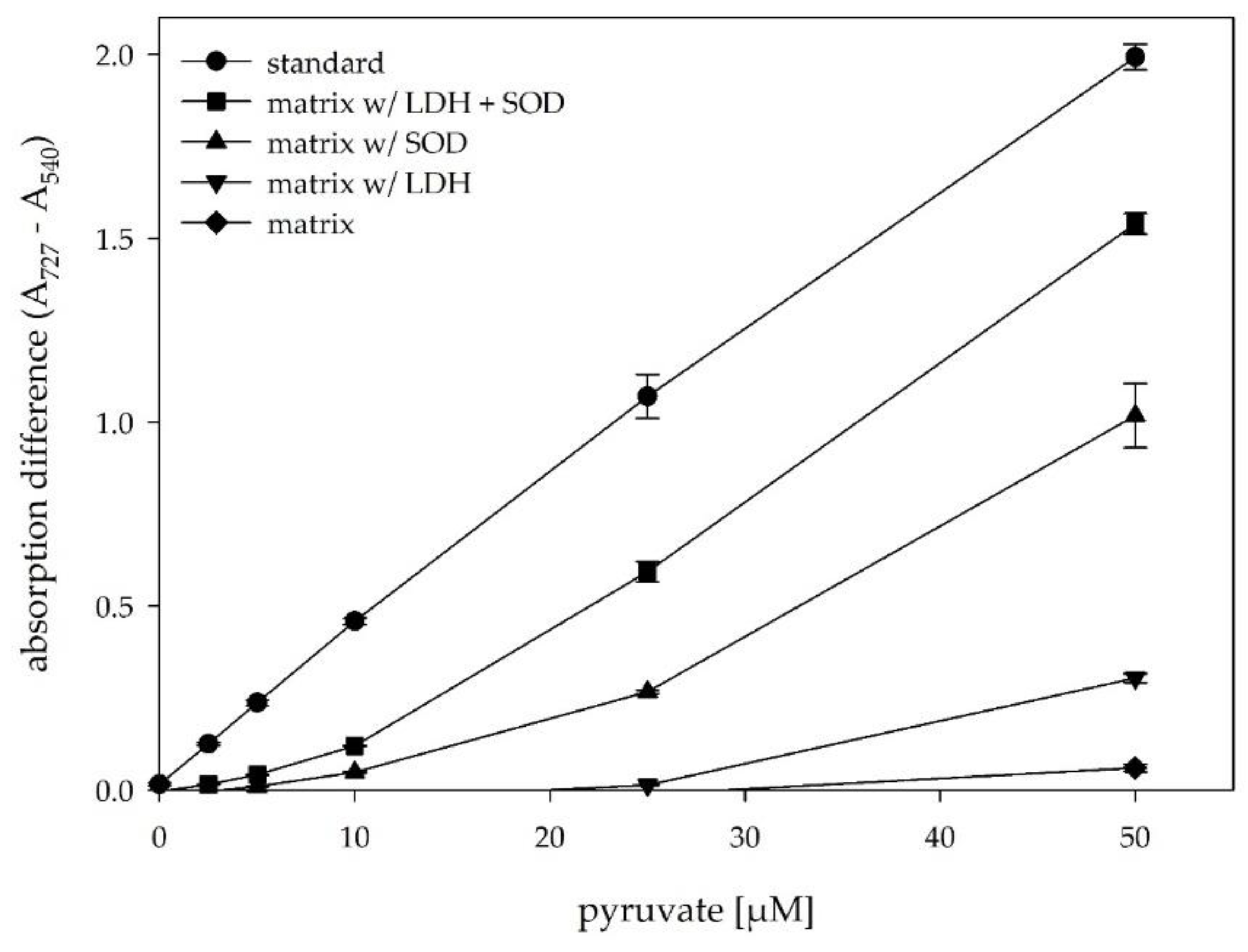

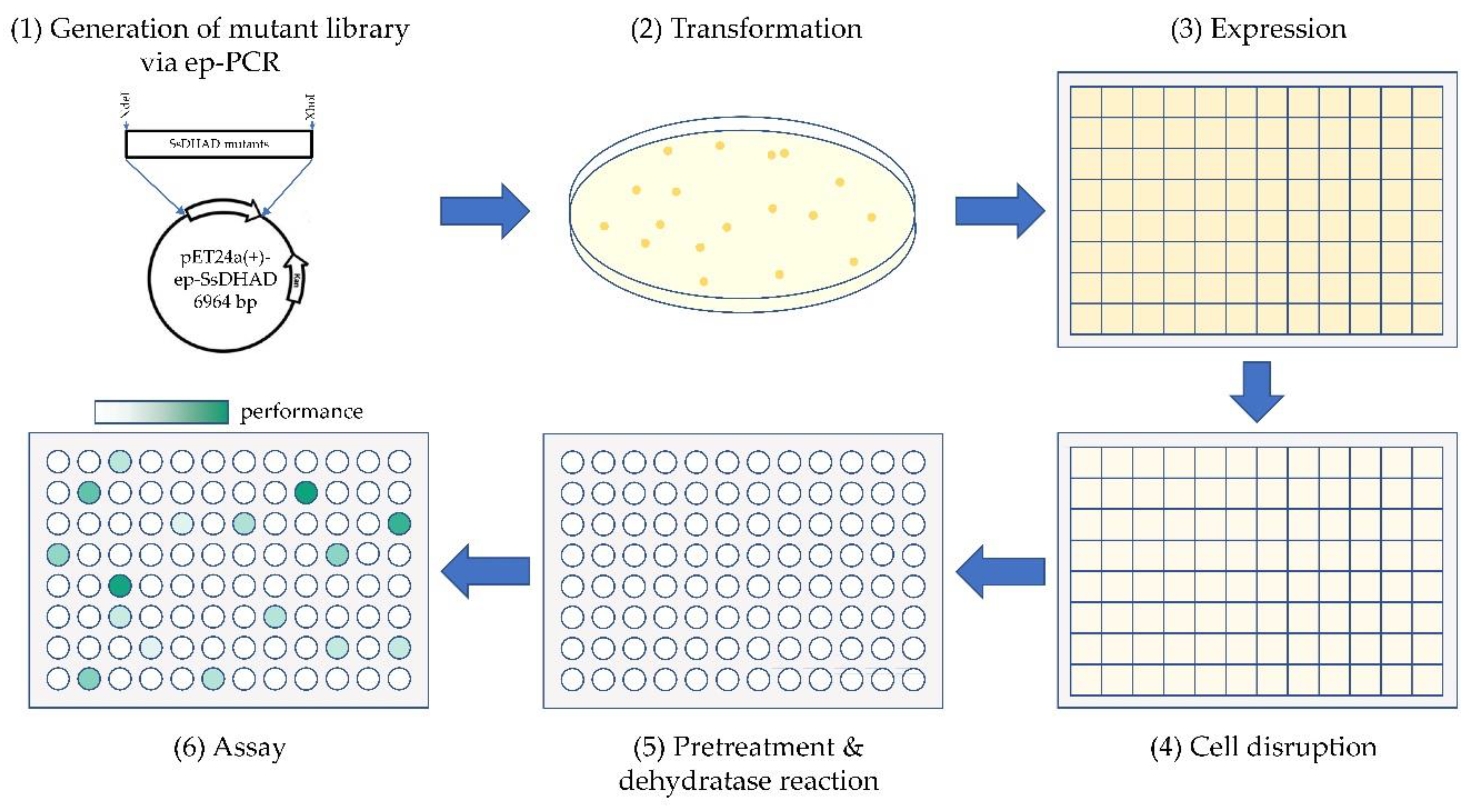

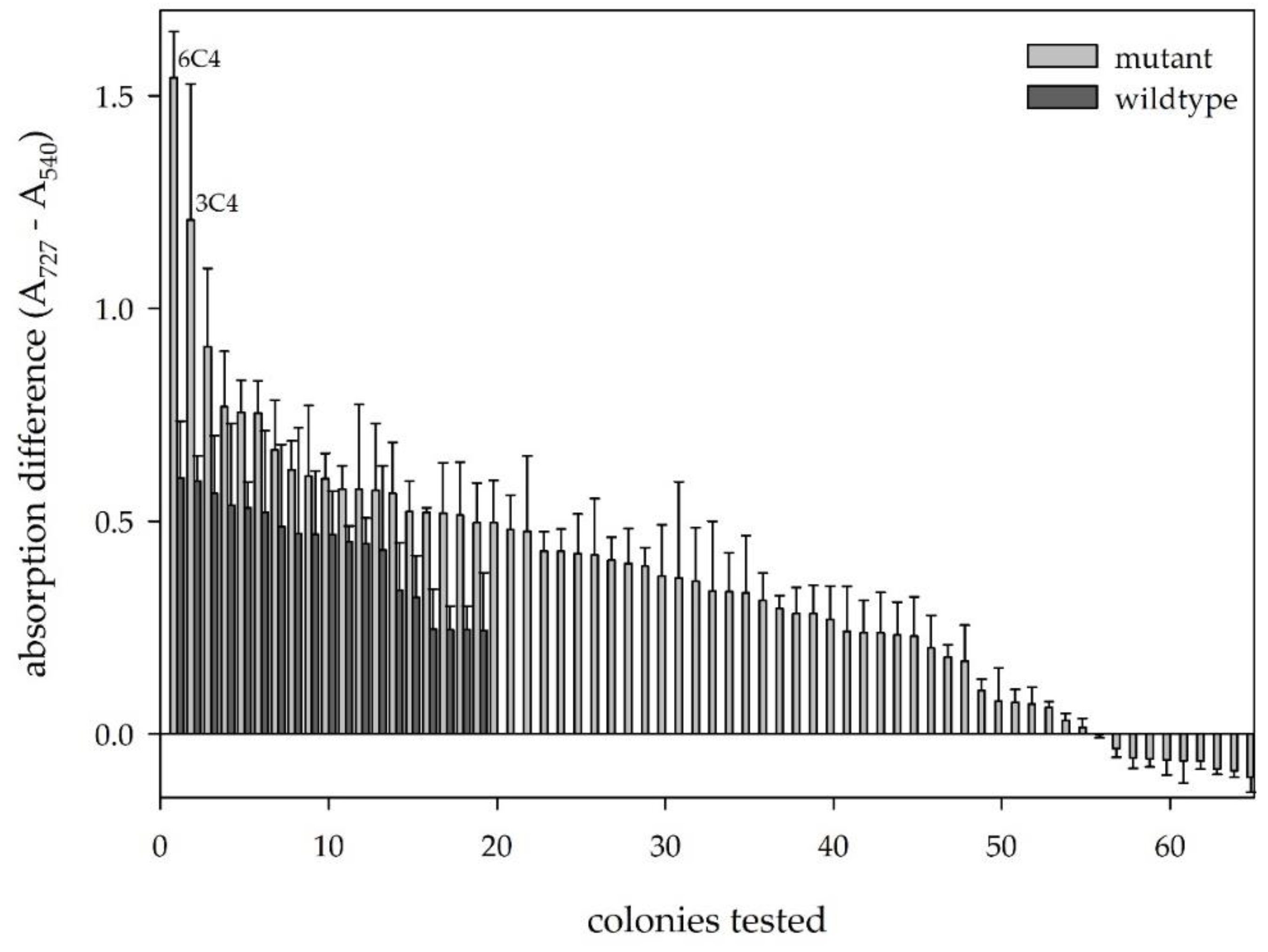
| Variant | Spec. Activity (D-Glycerate) [mU/mg] | Spec. Activity (D-Gluconate) [U/mg] | T1/2 [h] | Melting Temperature [°C] |
|---|---|---|---|---|
| Wildtype | 48.4 +/− 2.0 | 1.29 +/− 0.03 | 3.4 | 89.0 |
| 6C4 | 70.9 +/− 1.8 | 1.62 +/− 0.07 | 5.1 | 82.0 |
© 2020 by the authors. Licensee MDPI, Basel, Switzerland. This article is an open access article distributed under the terms and conditions of the Creative Commons Attribution (CC BY) license (http://creativecommons.org/licenses/by/4.0/).
Share and Cite
Begander, B.; Huber, A.; Döring, M.; Sperl, J.; Sieber, V. Development of an Improved Peroxidase-Based High-Throughput Screening for the Optimization of D-Glycerate Dehydratase Activity. Int. J. Mol. Sci. 2020, 21, 335. https://doi.org/10.3390/ijms21010335
Begander B, Huber A, Döring M, Sperl J, Sieber V. Development of an Improved Peroxidase-Based High-Throughput Screening for the Optimization of D-Glycerate Dehydratase Activity. International Journal of Molecular Sciences. 2020; 21(1):335. https://doi.org/10.3390/ijms21010335
Chicago/Turabian StyleBegander, Benjamin, Anna Huber, Manuel Döring, Josef Sperl, and Volker Sieber. 2020. "Development of an Improved Peroxidase-Based High-Throughput Screening for the Optimization of D-Glycerate Dehydratase Activity" International Journal of Molecular Sciences 21, no. 1: 335. https://doi.org/10.3390/ijms21010335
APA StyleBegander, B., Huber, A., Döring, M., Sperl, J., & Sieber, V. (2020). Development of an Improved Peroxidase-Based High-Throughput Screening for the Optimization of D-Glycerate Dehydratase Activity. International Journal of Molecular Sciences, 21(1), 335. https://doi.org/10.3390/ijms21010335




